Park Seo-Bo: Disciple of Nature
By HG Masters

Ecriture No. 140410, 2014, mixed media with Korean hanji paper on canvas, 130 × 200 cm. Photo by Park Seo-Bo Studio. Courtesy the artist and Kukje Gallery, Seoul/Busan.
As an artist, teacher, and organizer of influential avant-garde exhibitions, Park Seo-Bo is one of the preeminent figures in Korean art of the postwar period. Park’s retrospective “The Untiring Endeavorer,” appropriately titled after his infamously hard-working routine, held at the National Museum of Modern and Contemporary Art in Seoul in 2019, presented the breadth of his artistic practice. The survey dated to the mid-1950s when, as a young graduate, Park led the Informel group of expressive abstract painters before embarking on the dark, biomorphic Primordialis series (1962–66), and the later Hereditarius series (1968–69) of hard-edged, graphic abstractions mixed with elements of popular culture.
Despite being known for his forceful personality, Park began his most iconic works quietly in his studio in 1967. Inspired by his young son’s attempts at writing, these oil paintings are covered in repetitive graphite marks. He called the series Ecriture, or alternatively Myobeob in Korean, derived from the Chinese characters 描法, meaning “method of drawing.” He did not exhibit them publicly until 1973, at the urging of artist and friend Lee Ufan. Park remained a leading proponent of abstract painting in Korean art throughout the 1970s and 1980s. Later, a generation of artists known for their meditative, process-oriented abstraction— including Chung Chang-Sup, Chung Sang-Hwa, Ha Chong-Hyun, Kwon Young-woo, Yun Hyong-keun—would be formalized as the “Dansaekhwa” (meaning “monochrome painting”) artists by critic Yoon Jin Sup in 2000.
In the past decade, modernist movements in countries across Asia have started to receive the attention of international institutions, art historians, curators, and private collectors. While Park’s works and those by other Dansaekhwa artists have soared in visibility and price, his practice has continued to evolve. We corresponded as Park approached his 90th birthday in late 2021, before the opening of a new exhibition at Kukje Gallery in Seoul in September, where he was debuting a suite of recent Ecriture paintings, including several in vivid, new colors.
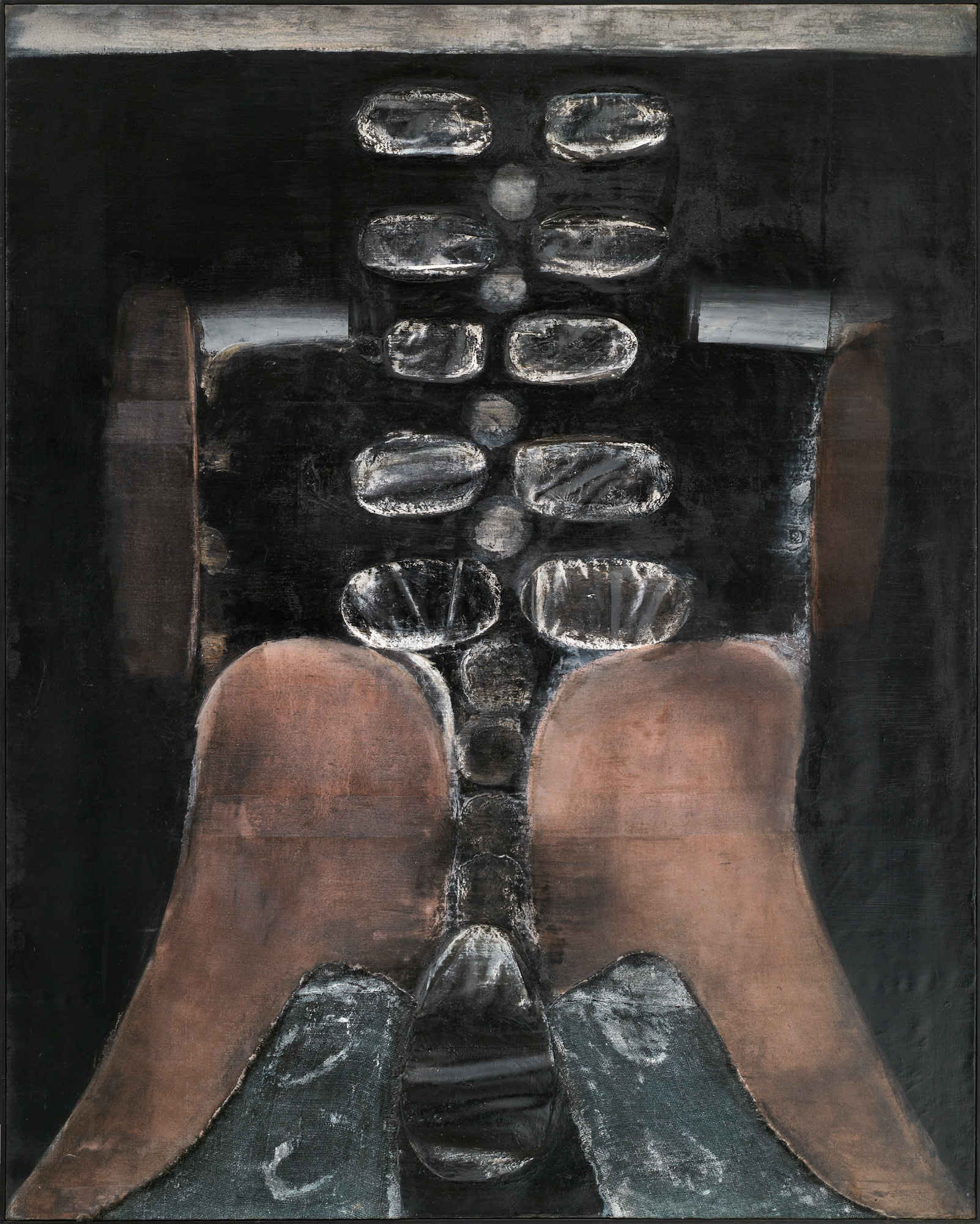
Primordialis, 1962, oil on canvas, 163 × 131 cm. Courtesy the National Museum of Modern and Contemporary Art, Korea.
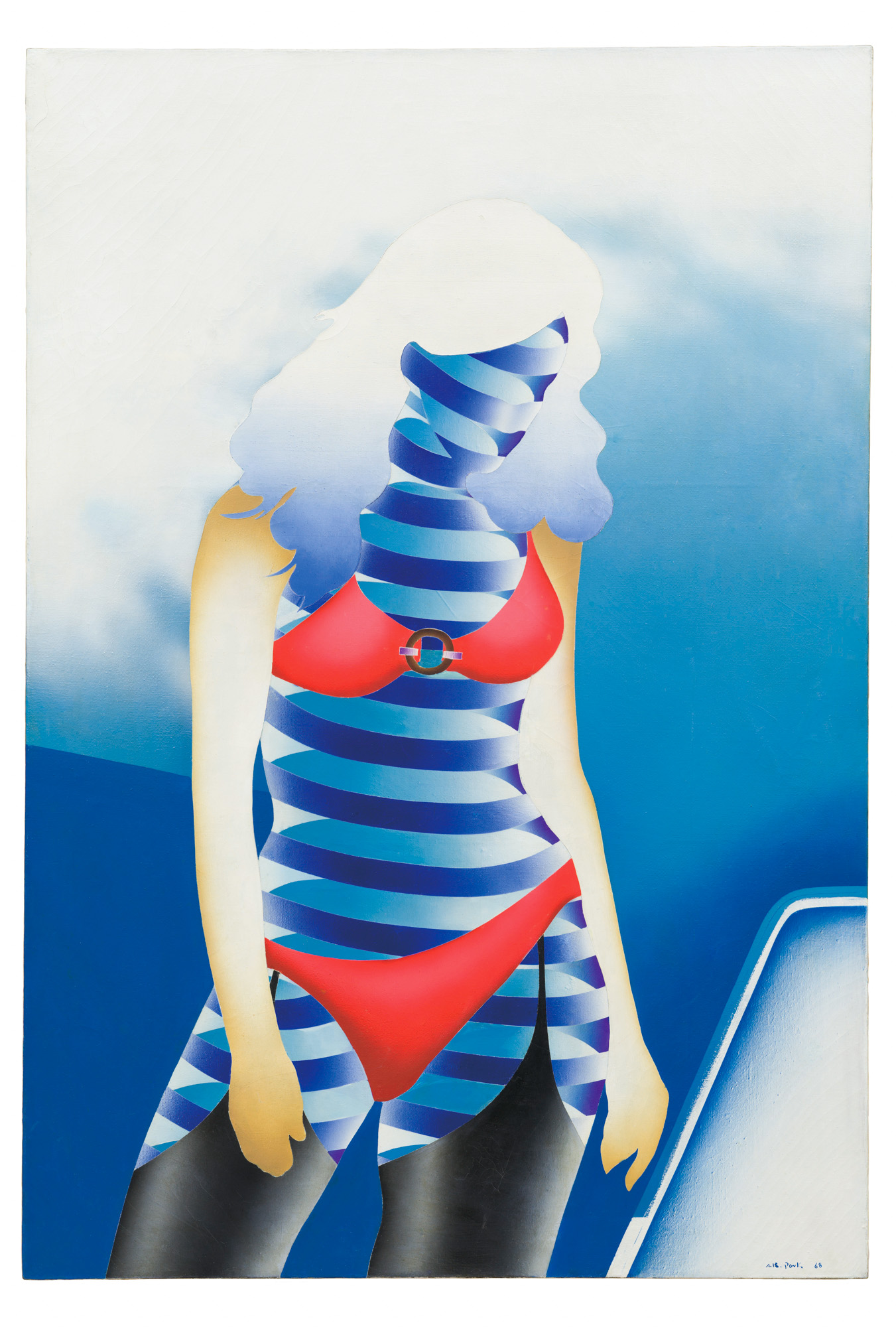
Woman in Bikini, 1968, oil on canvas, 130 × 89 cm. Courtesy the National Museum of Modern and Contemporary Art, Korea.
You have worked on the Ecriture series for more than 50 years now, and it has undergone many evolutions, from its early incarnation with pencil marks on white oil to the colorful vertical stripes and bars made from hanji (mulberry paper) and paint of the last two decades. Do you still think of your canvases as having a strong relationship with writing?
Ecriture means to write or to draw. But that isn’t the issue here—it’s about balance and harmony. Though I am lacking in many aspects, I can pride myself on being better than others in other ways. What I’ve realized over the years is that I must empty myself in order to soak up elements that I need, in order make myself more whole. And in order to empty myself, I must perform repetitive actions. It’s something I realized after countless discussions with the Buddhist nun and writer Kim Iryeop in 1955.
In contrast to Western artists, painting for me is a tool for self- cultivation and self-discipline. The traces, or remnants, of this action result in a painting. In this context, Ecriture signifies an endless repetition. The materiality or physicality that rises out of repetitive action—the ridges and furrows formed in the paintings after the hanji and paint are continuously pressed together—must be spiritualized. Only then does one understand Ecriture. There would be no Ecriture if this philosophical foundation topples. This foundation is also the bedrock of Dansaekhwa, which is something you can’t find in Western art.
There’s always a sense of purpose in Western art—and that purpose is to express one’s thoughts. And successfully conveying that intention to the fullest extent is the definition of a “good work of art.” But in my case, the actions are completely devoid of purpose as I am emptying myself of everything. Self-cultivation can only come with repetition.
Though your later Ecriture works are highly abstract, the elements of the composition—such as flat, horizontal areas that might resemble the horizon, or smooth, vertical forms that might look architectural—introduce elements of space. They can also appear as voids for contemplation. How would you like viewers to experience your work?
It is a spiritual window for breathing. That’s what I told a friend of mine—who is a professor at the University of Melbourne—when he once visited me at my studio. He was wondering what the “stairs” and “columns” in my paintings were and when I told him, he was delighted to hear the phrase “spiritual window.” My friend, who is of Greek ethnicity, told me that the term “spiritual window” exists in ancient Greek philosophy. He completely identified with the idea of me physically placing my nose close to the “window” of the painting and taking deep breaths. Because this wasn’t a deliberate artistic decision, I began to think about where this might have come from.
Decades ago, I used to live on the eighth story of an apartment in Seoul’s Yeouido area, facing the Bamseom, a pair of islets in the Han River. I often spent time in my study, where I read books and drew my Esquisses (1996– ), and looked down onto the river where the iconic Han River Bridge connects the north and south sides of the city. Strangely enough, I never found that view very impressive. But as time passed, I found myself looking at the view further away. Spotlights were turned on from the bottom of the Mapo and Seogang Bridges every nightfall and the view was breathtaking. I was able to see the geometry of the vertical columns supporting the bridges very clearly. Similar geometries began to appear in my subsequent Esquisses, and eventually in my paintings. The stair formation comes from the view I have of Yeouido from my current home—from the rugged outlines of the skyscrapers.
I have also been reflecting on another experience. I visited Jeju Island with my wife on a crisp autumn day. The weather was clear, and the sky was beautiful. On our way back home, I asked the cab driver to take the long route, just so that we could look at the sky and ocean for a little longer. From a distance, it seemed like the two were bound together. I observed the view again during sunset, when I saw a clear horizontal line separating the air and water. So that’s when horizontal blocks began to appear in my work. This is the reason why I say that nature is my teacher.
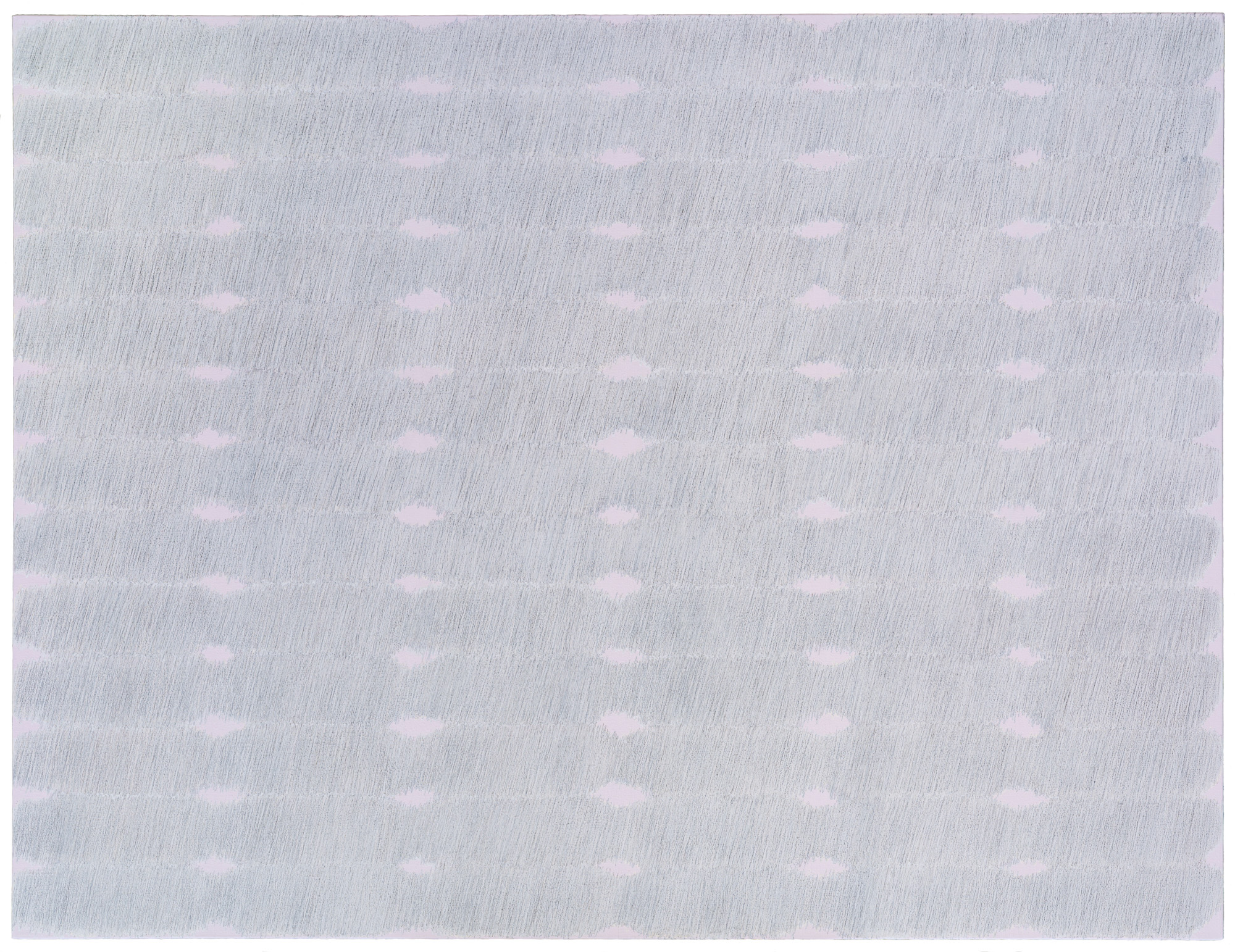
Ecriture No. 190227, 2019, pencil and oil on canvas, 130 × 170 cm. Photo by Park Seo-Bo Studio. Courtesy the artist and Kukje Gallery, Seoul/Busan.
At the beginning of the 21st century, you reflected on the world’s transition from the analogue to digital, and decided to use color as a “healing mechanism.” What have you discovered through your use of colors over the last two decades?
I was in agony at the turn of the century. I was quite successful during the first 70 years of my life—in the 20th century—during the analogue times, but I was far from confident in the face of the digital age. Failure now would mean that my past 70 years would crumble. So many times, I had been tempted to give up but I always decided to trudge through in the end. I’m a fighter.
As expected with all things digital, change became impossibly rapid. There were many who couldn’t keep up with these changes. It was like the entire world had become a psychiatric hospital. Everyone seemed to be struggling with mental-health challenges. Shootings at random passersby, ruthless massacres, and so on.
I spent a lot of time thinking about the role that art must play in today’s world. My Ecriture works were not made to announce my thoughts and opinions. They are not meant to burden my viewers. But should that really be all there is to it? Because I had always worked with the philosophy of emptying myself, my paintings did not come across as burdensome or oppressive in any way. People felt comforted when viewing my works. That’s why I decided that my works must serve as a means to heal the stress and anxiety of my viewers. And the answer to how was in the colors from nature. I started incorporating different colors in my paintings in the early 2000s, and it was around 2005 that I started using a more diverse spectrum of colors. Then, around 2010, I started introducing two colors in a single painting with a different color painted onto the background to make the base color appear even more beautiful.

Ecriture No. 120715, 2012, mixed media with Korean hanji paper on canvas, 130 × 200 cm. Photo by Park Seo-Bo Studio. Courtesy the artist and Kukje Gallery, Seoul/Busan.
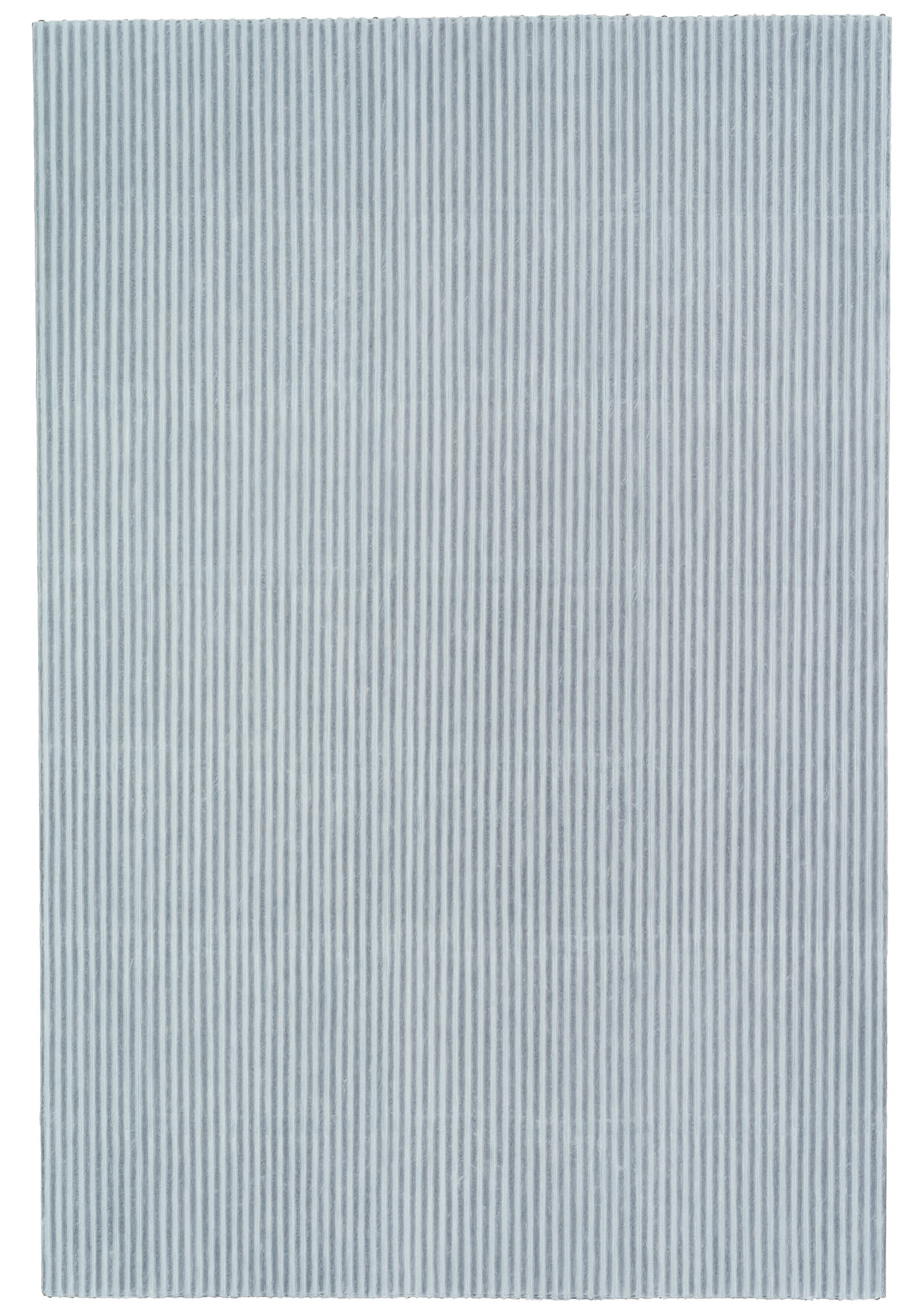
Ecriture No. 161120, 2016, mixed media with Korean hanji paper on canvas, 200 × 130 cm. Photo by Park Seo-Bo Studio. Courtesy the artist and Kukje Gallery, Seoul/Busan.
How did you find the colors that you wanted to use?
I was invited to present a solo exhibition at Tokyo Gallery in 2000 to celebrate my 70th birthday. I found it a little strange since I had already held a solo exhibition with them only two years earlier, but agreed under one condition: the exhibition must be staged when autumnal colors reach their peak. I told the director that I wanted to see maple trees. We ended up going to the Fukushima Dam and Mount Bandai to see them. We climbed up Mount Bandai and the moment I looked down into the valley, I couldn’t help but exclaim in awe. The maple trees glowed a bright neon red when directly exposed to sunlight. But when the wind took hold of the leaves, their blackish, dark red undersides were exposed. The bright red maple colors looked even brighter with the sunset. I felt the flaming red pierce my heart, as if it was about to burn me to death. I hadn’t felt so strongly about nature up until then, but at that moment I just had to succumb to its grandeur. I thought to myself, “These are colors that us painters will never be able to come up with.” But, captivated by the pure beauty, I was determined to translate this moment of shock in my paintings. I said: “I want to recreate this beautiful color of nature on my canvas.”
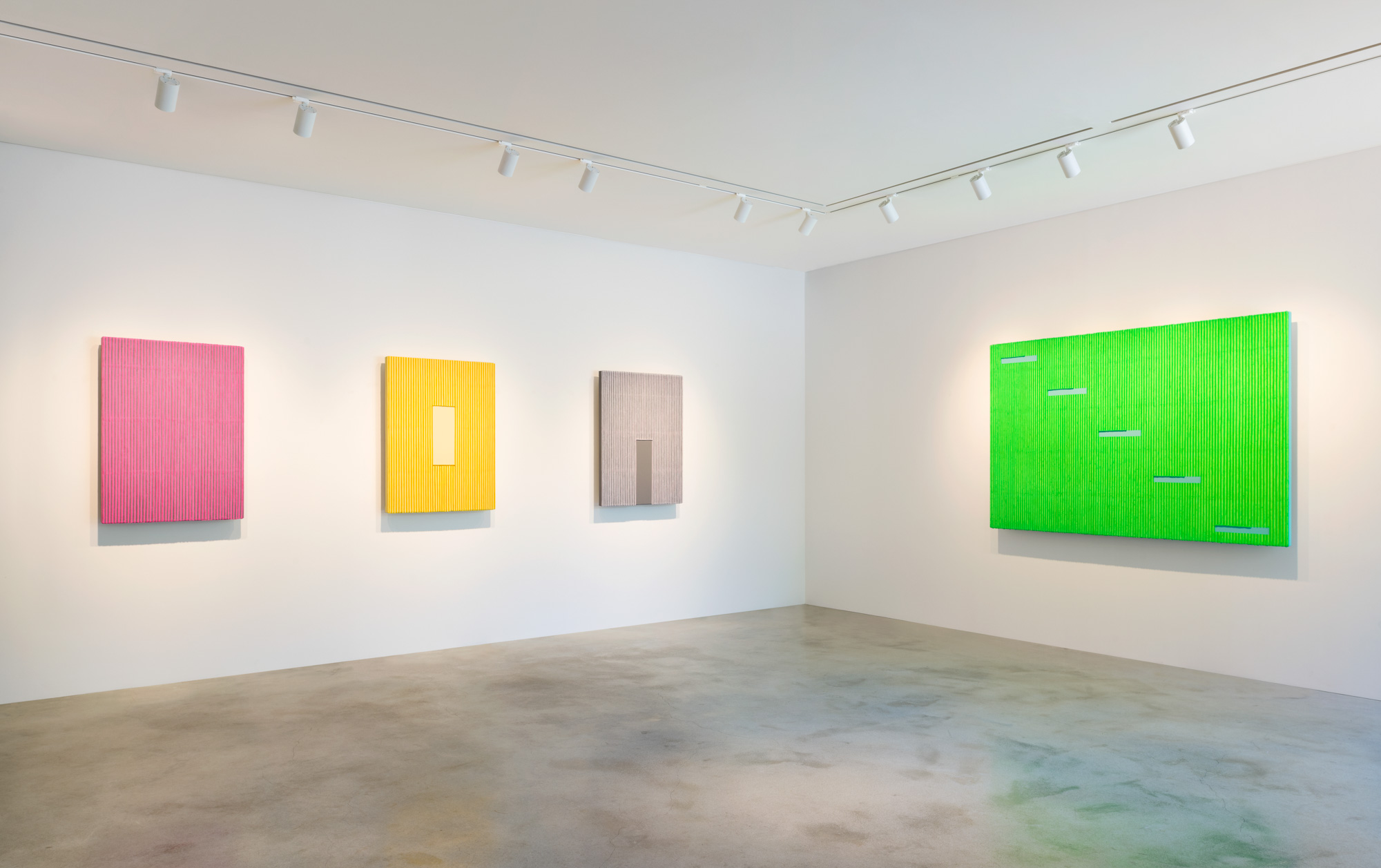
Installation view of PARK SEO-BO’s solo exhibition at Kukje Gallery
Do you have specific associations with the colors you use?
I have spent a lot of time in Jeju since I built a house there. There’s a mountain called Seongsan where vibrant yellows come from the Forsythia flowers that bloom every spring, and from the fields of rapeseed, which are truly an amazing sight to behold. The color when the leaves first start to blossom is quite refreshing and is further enhanced on a fresh, dewy morning after a night of rain. I made that light green color and painted it as a background, then started drawing with the color of the Korean rosebay, a light pink. When the cherry blossoms begin to wither, I observe the fallen buds on the ground very closely. Some are white-ish, while others border on reddish. Some are a milky, murky pink. I never realized these flowers were so beautiful when I was younger.
For the blues, sometimes the ocean and the sky merge together to appear as one in my eyes. The color of the ocean on the horizon is a lot different from the deep blue color of the sea seen from a closer distance. In my new works, I’m trying my best to convey the subtle difference in color as well. I’ve always endeavored to bring these profound colors into my paintings.
Viewers are often astonished by the fact that I can replicate these colors from nature. Once these colors enter my work, they have the power to heal. It’s difficult to accomplish this with paint, but I’ve always prided myself on my eye for and use of color. And many have agreed, including Kim Whanki and Do Sang-bong. Do often said that he would have liked me better had I not been a part of anti- Kukjeon (the anti-National Art Exhibition movement in 1956)—and that I had an exceptional command of the color white.
Your work has a high degree of craftsmanship in its execution— how do you see the relationship, or differences, between your artworks and works of skilled artisans?
I consider myself no different than those artisans. If there’s one thing that’s different, it’s that these people make objects that are put to practical use, whereas I paint to empty myself through repetitive action. I don’t think that one is above the other. That’s called arrogance. Such thoughts will only lead to your downfall. You have to be even more alert to your surroundings when everybody’s praising you. You always have to stay humble and set an even higher standard for yourself as time goes by. I’ve been consciously telling myself to stay humble all these years and have never gone around boasting. Of course, there have been times when I was very proactive, leading anti-government groups in the arts, but that’s a bit different from adopting an arrogant attitude.

PARK SEO-BO working on an Ecriture painting in his Hapjeong-dong studio in 1977. Image via Wikipedia.

View of PARK SEO-BO’s studio-home, the Gizi Foundation, in Seoul. Photo by Kim Soung Soo. Courtesy Gizi Foundation and Kukje Gallery, Seoul/Busan.
What do you believe traditional elements of culture can offer us in our contemporary world? What should we learn from the past?
When I first began my Ecriture series, my repetitive action was done with a pencil. That changed with time, however. Everything, everyone changes with time, and so do I. If you remain as you are throughout the changing times, you’ll become derelict. I don’t deliberately try to depict our current times but the milieu naturally appears in my art. That’s a true reflection—this is why people say that art is a representation of our times. Some works of art try so visibly hard to be relevant but I don’t see that as a reflection, that’s a mere token of our times.
Tradition reflects the zeitgeist, and the contextual elements that constitute the zeitgeist come together to create tradition. Which is why tradition changes with time. So, for example, only a Korean knows, or can do, something “Korean” or something that alludes to “Korean-ness,” but I wouldn’t say that it’s prudent to merely bring forth a prominent Korean art movement of the past and adapt it to a more contemporary style—tradition doesn’t necessarily take a particular form, it’s intangible. It’s a matter of spirituality. For instance, the guiding values of the Yi period [1392–1910] of the Joseon dynasty, as dictated by royalty, led the direction for the colors and forms of the ceramic jars and pottery of the time. Before that, the Buddhist values of the Goryeo Kingdom [918–1392] had introduced a whole new body of celadons. The Yi period was not Buddhist—Confucian values were dominant. So that’s when the Joseon white porcelains were first introduced. And even with the Joseon white porcelains, there are early, mid, and late periods—they’re subdivided according to the changing times of the Joseon dynasty. What’s interesting is that these potters were not academic. Despite their simplicity, the white porcelains can be categorized into periods, which illustrates my point that the milieu naturally appears in art.
In the context of changing with the times, I had my first son in my thirties and doted on him immensely. But now that my children have long since come of age, fatherhood is a different story. Today, my surroundings are my teacher—namely, nature. First of all, nature changes with the times. And secondly, I incorporate manmade structures in my idea of nature and surroundings. When I sometimes go out to Gangnam or Yongsan, I see a new edifice and think that the neighborhood is looking better every day. Then I pass by some display windows—they also change with the seasons, and by year. And that’s another way I intuitively realized that sensibilities change with time.
What do you think is your legacy and your generation’s contribution to culture in Korea?
The first would be the acknowledgment of painting as a means for meditation and self-discipline, which is where all my work begins. What’s so special about Dansaekhwa? Western art is all about expressing yourself, whereas Korean art puts more focus on nature. We believe that when we put too much focus on ourselves, it inevitably harms nature. Korean art is about emptying one’s mind, letting go of our egos, and returning to nature to coexist with it. So I would say one of the cultural legacies we’re proud to leave behind is the continuous reiteration of purposeless action, which leads to another world of purposelessness. The infinite repetition of action can be likened to the practice of monks who repetitively beat a wooden drum in order to empty their minds and thereby achieve a state of zen.
I played a crucial role in leading the Korean Dansaekhwa movement. I first came up with the idea, kept insisting on it, and, soon after, other artists gradually decided to be part of the movement. Apparently, during an interview that Lee Ufan did in Shanghai, where he was visiting for a three-person exhibition at the Power Station of Art in 2019, he said: “If it weren’t for Park Seo-Bo’s contribution [in the 1970s], there wouldn’t have been the Dansaekhwa movement, which he helped foster along with Yun Hyong-keun, Chung Chang-Sup, and Ha Chong-Hyun.”
To be strict, the term “Dansaekhwa” is a misnomer because the tonal aspect isn’t what distinguishes our movement from others. The term is derived from a Western point of view; it is a name created to place the movement in the context of Western art history. In fact, the art of Dansaekhwa is not so much about the color as it is about the essence of the action itself—the repetitive gestures that empty and cultivate the painter’s mind.
As you approach your 90th birthday, what are your plans for the next decade?
I continue to paint every day and will have a show during the Venice Biennale next year. Two museums that will house my art are underway. In Seoul, a museum in Jongno-gu is being built, and another, in Jeju, is a private museum that doesn’t belong to a specific municipality—they’re planning to display my paintings under the name of Park Seo-Bo Art Museum.

Portrait of PARK SEO-BO. Photo by Kim Youngrim. Courtesy Kukje Gallery, Seoul/Busan.
.jpg)






